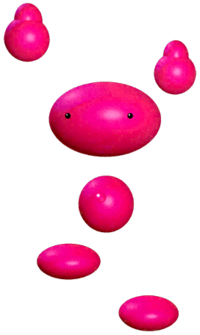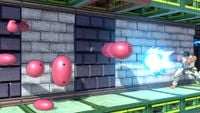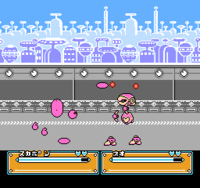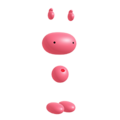Sukapon
| Sukapon | |
|---|---|
  Official artwork of Sukapon from Joy Mech Fight. | |
| Universe | Joy Mech Fight |
| Debut | Joy Mech Fight (1993) |
| Smash Bros. appearances | Ultimate |
| Most recent non-Smash appearance | Joy Mech Fight (1993) |
| Console/platform of origin | Famicom |
| Species | Robot |
| Gender | Male |
| Place of origin | Japan |
| Designed by | Noriyuki Harada |
Sukapon (スカポン, Sukapon) is the main character of Joy Mech Fight.
Origin
Sukapon was made by Dr. Little Emon and Dr. Ivan Walnuts. When Dr. Walnuts declared his intent to rule the world, Dr. Emon used Sukapon to defeat Dr. Walnuts's robots and stop his evil scheme. After an epic battle on the moon and a change of heart by Dr. Walnuts (apparently due to a split-personality), Sukapon returned to a career as a stand-up comedian.
Sukapon is the most basic robot playable in Joy Mech Fight with the most basic of attacks, and so he is mostly played by newcomers and those looking for a challenge. His specials consist of a suplex-like throw, a rolling attack which can be executed in a variety of ways (including a glowing, powerful jump-attack if a secret input is quickly pressed), and two head-tossing moves: one of which can be used for movement, and one of which is a projectile. His most distinctive feature is that he has the same speed whether walking forward or backward; though a relatively slow speed going forward, he is rather fast for backing up.
In Super Smash Bros. Melee
Sukapon was originally going to be an item in Melee, and would have been able to be jumped on by characters, but was cut for "adult matters".[1]
In Super Smash Bros. Brawl
Sukapon appears as a sticker in Brawl.
Sticker
| Name | Game | Effect | Characters |
|---|---|---|---|
| Sukapon | Joy Mech Fight |
 Sukapon (Joy Mech Fight) |
In Super Smash Bros. Ultimate
As an Assist Trophy

Sukapon appears as an Assist Trophy in Ultimate. He moves around the stage while spinning around with his arms raised and can jump, flailing his hands whenever airborne. He attacks by using his special move, Tondeker, which shoots a copy of his head at opponents. He uses a second special move, Sukapon Toss, where he uses a close grab then tosses opponents backward. He also uses a third special move, Sukapon Roll, where he rolls his whole body forward fast, then continues to spin when rebounding off opponents. Sukapon can also block attacks just like in Joy Mech Fight, but is still vulnerable to grabbing. Sukapon has small black dots for eyes but will have a circle surrounding the dot when attacked or in his Tondeker head projectile, giving off a surprised expression. He claps his hands and moves his feet side to side when finished, a reference to his victory animation in Joy Mech Fight. Like many Assist Trophies in Ultimate, he can be defeated. Training Mode describes his Assist Trophy: Spins around and tackles opponents, occasionally chucking his own head.
Spirit
Sukapon is also a Legend-class spirit, available in the Spirit Board or in the shops. His spirit fight is a stamina battle against Mii Gunner (meant to represent Dr. Little Emon[2]), whose attack power periodically increases, on Coliseum, with Sukapon constantly appearing as a hostile Assist Trophy.
| No. | Image | Name | Type | Class | Slots | Base |
Max |
Base |
Max |
Base |
Max |
Ability | Series |
|---|---|---|---|---|---|---|---|---|---|---|---|---|---|
| 1,140 | Sukapon | ★★★★ | 2 | 4251 | 10630 | 2106 | 5265 | 1905 | 4764 | Strong Throw | Joy Mech Fight |
Gallery
Grabbing Luigi.
Trivia
- Sukapon was the most requested miscellaneous Nintendo character for inclusion in Super Smash Bros. Melee.[3]
Names in other languages
| Language | Name |
|---|---|
| スカポン, Sukapon | |
| Sukapon | |
| Sukapon | |
| Sukapon | |
| Sukapon | |
| Sukapon | |
| Sukapon | |
| 스카퐁, Sukapon | |
| Sukapon | |
| Скапон |
References







